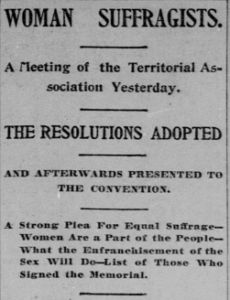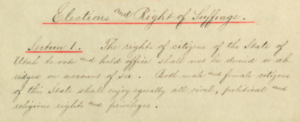Suffrage in Utah’s Constitutional Convention
By Katherine Kitterman and Rebekah Clark
April 18, 2020
125 years ago, in the spring of 1895, delegates gathered in Salt Lake City to write a state constitution for Utah. Each of the 107 male delegates came to the convention pledged to support women’s equal voting rights. Utah suffragists had spent the past five years laying the groundwork for restoring women’s suffrage when Utah finally became a state, and most Utahns supported women’s right to vote. Still, suffrage quickly became the most hotly-debated topic of the convention.
What could suffragists do once the debate got going?

Lucy Heppler, Sevier County suffrage leader, illustrated by Brooke Smart.
Congress had invited Utah to apply for statehood in July 1894, and suffragists were ready.[1] They already agreed with Susan B. Anthony’s advice: “Now in the formative period of your constitution is the time to establish justice and equality to all the people…. Once ignored in your constitution–you’ll be as powerless to secure recognition as we are in the older states.”[2], [3]
For the past five years, Utah suffragists had been working through Utah’s Woman Suffrage Association (UWSA) to educate each other, recruit supporters, raise funds, march in parades, lobby politicians, and attend conventions, all aimed at regaining the ballot once Utah could write its own constitution. So they made sure both political parties pledged support for restoring women’s equal voting rights.[4]
Women couldn’t vote to elect delegates to the constitutional convention, but they campaigned for pro-suffrage candidates by speaking at rallies and holding debates. Dr. Ellen Ferguson, Salt Lake County Woman Suffrage Association president, encouraged women to “interview the members elected to see if they intend to place women side by side with men in the constitution,” and to remind them of their party’s pro-suffrage promises.[5]

Salt Lake Herald-Republican, March 19, 1895.
Suffragists also planned a public display of force when the constitutional convention opened in March 1895. The Committee on Elections and Suffrage considered a suffrage clause taken from the Wyoming state constitution, that would allow women citizens both to vote and to hold office.[6] As those discussions continued, about 100 UWSA leaders from across the Territory met in the Salt Lake City and County Building just down the hall from the constitutional convention. After drafting a petition, they filed into the convention hall to hear it read to the delegates: “The women of Utah are by no means indifferent spectators to the drama that is now being enacted.”[7]
The next day, suffragists brought out the big guns to testify in a committee hearing about the benefits of suffrage. The speakers spanned the generations of Utah women who had voted between 1870 and 1887, including Civil War nurse Joanna Melton, Utah’s first female lawyer Georgiana Snow Carleton, long-time suffrage leaders Sarah M. Kimball and Emmeline B. Wells, and rising stars Emily S. Richards and Dr. Martha Hughes Cannon.[8]
When the issue of suffrage came to the full convention on March 28, B. H. Roberts fired the opening salvo—arguing that including suffrage in the constitution could jeopardize its passage by Utah voters and its acceptance by Congress. He wanted to submit the question of women’s suffrage as a separate issue to the voters after Utah statehood. You can read more about the ensuing debate in our post here and the official transcripts here.
Hundreds of spectators crammed into the convention hall to hear the spectacular oratory, led by B. H. Roberts on one side and Orson F. Whitney and Franklin S. Richards on the other. The majority of delegates supported suffrage, but they agreed to give Roberts, a powerful public speaker, extra time to make his argument. Ruth May Fox, UWSA treasurer, wrote in her diary “What a shame he does not use his eloquence in a better cause.”[9]
Roberts’ Davis County constituents actually tried to recall him for his anti-suffrage stance, but the question he had stirred up swept the Territory.[10] Business interests and Utahns opposed to suffrage began holding public meetings, and even some prominent Utah suffragists like Jennie Froiseth and Charlotte Godbe Kirby signed calls for “separate submission.”[11]
As petitions began circulating in support of separate submission, suffragists marshaled their forces once again to gather signatures in favor of women’s right to vote. Delegates voted 75 to 14, with 12 absent, in favor of suffrage on April 5, but they agreed to vote again after more petitions could be gathered. Suffragists like Ruth May Fox and Lucy Heppler circulated petitions door-to-door and sent them to their elected delegates from more than 20 counties. To see how your county participated, check out our pages for local suffrage history.
In just two weeks, the convention received 24,801 signatures for inclusion and 15,366 for separate submission.[12] Thanks to the last-ditch efforts of Utah suffragists and their allies in the convention, suffrage passed a final vote on April 18. This ensured that women citizens’ right to vote and hold public office would be enshrined in the state of Utah’s founding document, once approved by Utah voters and Congress. “We all felt it a great day in the history of Utah,” wrote suffragist Ruth May Fox in her journal. “It seems almost too good to be true that we have equal suffrage,” wrote Emmeline B. Wells, UWSA president, in hers. The convention voted to approve the proposed constitution on May 6, and Utah voters overwhelmingly passed it that November.

Utah State Constitution, Article 4.
On January 4, 1896, Utah women citizens regained the right to vote with these words: “The rights of citizens of the State of Utah to vote and hold office shall not be denied on account of sex. Both male and female citizens of this State shall enjoy equally all civil, political and religious and privileges.”[13]
There’s much more that went into this suffrage victory. Check out our history pages for each Utah county to see how suffragists organized in your community, and follow us on social media @betterdays2020 for posts about grassroots women’s rights leaders from every corner of Utah.
[1] Enabling Act text in “Utah’s Road to Statehood” digital exhibit, Utah State Archives.
[2] “Susan B. Anthony’s Letter,” Woman’s Exponent 23, no. 3-4 (Aug. 1, and Aug. 15, 1894): 169.
[3] Check out this interactive map to see where suffrage measures were approved and defeated (mostly defeated) in individual states https://depts.washington.edu/moves/WomanSuffrage_map.shtml.
[4] “Rawlins and Victory,” Salt Lake Herald-Republican, September 16, 1894, 6.
[5] “S.L. Co. Convention,” Woman’s Exponent, December 1, 1894, 211.
[6] “Getting Down to Business,” Salt Lake Herald-Republican, March 12, 1895, 1.
[7] “Woman Suffragists,” Salt Lake Herald-Republican, March 19, 1895, 3.
[8] “Convention Chat,” Salt Lake Herald-Republican, March 20, 1895, 3.
[9] Ruth May Fox, diary, April 1, 1895, LDS Church History Library.
[10] “Roberts Asked to Resign,” Salt Lake Herald-Republican, March 31, 1895.
[11] “Vox Populi,” Salt Lake Tribune, April 6, 1895, 5. The Salt Lake Tribune espoused anti-suffrage views during the constitutional convention.
[12] “Proceedings and Debates of the Convention Assembled to Adopt a Constitution for the State of Utah,” courtesy of the Utah State Archives.

